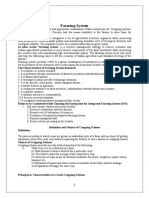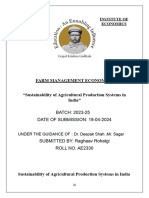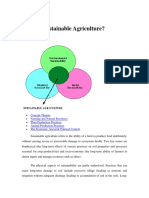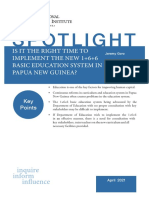Professional Documents
Culture Documents
Impact of Low External Input Agriculture (Leia) and High Eternal Input Agriculture (Heia) On Crop Productivity
Impact of Low External Input Agriculture (Leia) and High Eternal Input Agriculture (Heia) On Crop Productivity
Uploaded by
Phil AkipeOriginal Description:
Original Title
Copyright
Available Formats
Share this document
Did you find this document useful?
Is this content inappropriate?
Report this DocumentCopyright:
Available Formats
Impact of Low External Input Agriculture (Leia) and High Eternal Input Agriculture (Heia) On Crop Productivity
Impact of Low External Input Agriculture (Leia) and High Eternal Input Agriculture (Heia) On Crop Productivity
Uploaded by
Phil AkipeCopyright:
Available Formats
Lecture No.
12
IMPACT OF LOW EXTERNAL INPUT AGRICULTURE (LEIA) AND
HIGH ETERNAL INPUT AGRICULTURE (HEIA)
ON CROP PRODUCTIVITY
Low External Input Agriculture:
The term low input agriculture has been defined as production activity
that uses synthetic fertilizer or pesticides below rates commonly
recommended by the Extension Service. It does not mean elimination of these
materials. Yields are maintained through greater emphasis on cultural
practices, IPM and utilization of on-farm resources and management.
The term low-input farming has often been used to describe any system
of alternative agriculture, if can be seen that it is distinctly different from
organic farming etc. nevertheless any system that reduced purchased
chemical inputs can be called low input farming, some examples are :
1. Poultry litter can replace nitrogen fertilizers in the production of
watermelons.
2. Legume cover crops can supply the total nitrogen requirements of
pecan trees.
3. Compost amended potting mixes produce superior vegetable
transplant than traditional soilless mixes.
4. No-till vegetable systems are feasible using reduced herbicides rates
to kill cover crops.
5. Subterranean clover living mulches supply nitrogen and weed
control in peach orchards.
Criteria for LEISA: (Low External Input Sustainable Agriculture)
A] Ecological criteria:
1. Balanced use of nutrients and organic matter.
2. Efficient use of water resources
3. Diversity of genetic resources
4. Efficient of genetic resources
5. Efficient use of energy resources
Mr. S.S. Nitave M.Sc. (Agri.) NET
6. Minimal negative environmental effects
7. Minimal use of external inputs
B] Economic criteria:
1. Sustained framer livelihood systems
2. Competitiveness
3. Efficient use of production factors
4. Low relative value of external inputs
C] Social criteria:
1. Wide-spread and equitable adoption potential, especially among
small farmers
2. Reduced dependency on external institutions
3. Enhanced food security at the family and national level.
4. Respecting and building on indigenous knowledge, beliefs and value
systems
5. Contribution to employment generation.
High External Input Agriculture (HEIA):
High External Input Agriculture (HEIA), production for the far off
markets necessitated use of external inputs like chemical fertilizers, hybrid
seeds, pesticides, irrigation etc. Increased dependency on high cost external
inputs in agriculture also made farmers to depend on external credit on a
regular basis. Cultivation of cash crops like cotton and tobacco, also led to
scarcity of fodder. This resulted in farmers giving up animal husbandry,
thereby resulting in acute scarcity of farmyard manure and making the use of
chemical fertilizers inevitable.
Mr. S.S. Nitave M.Sc. (Agri.) NET
DIFFERENCE BETWEEN LEIA AND HEIA :
Sr. Characteristics of LEIA Characteristics of HEIA
No.
1. LEIA realies on the optimal use of The farming pattern depends
natural processes. heavily on external and chemical
inputs.
2. The focus is on the sustainability The focus mainly on maximizing
of farming system yields coupled with increasing
specialization of production
3. Environmentally sound and that There is a great damage to the
have the potential to contribute to environment
the long-term sustainability of
agriculture.
4. HEIA depends on the higher HEIA depends on the higher
production and profit, without production and profit, without
consideration of the local needs consideration of the local needs
and local market. and local market
5. Greater diversification on farm low The number of products and
risk of failure and market commodities are very minimum,
fluctuation. lack of diversity in the farming
practices; as a result, there is
greater risk of failure and price
fluctuation.
6. LEIA maintains a healthy soil, Under HEIA system, soil quality
recycling nutrients on the farm, deteriorates, and there is
and utilizing approaches such as resurgence of pests, lack of
integrated pest management (IPM). resilience in the soil-plant
system
7. Best bet technologies, for example, In HEIA, there is lack of use of
soil and water conservation indigenous technologies.
(terraces, ditches, and vegetation
strips on sloping land), better
timing of operations, improved
crop spacing and densities,
manure or compost and water
application based on local
conditions.
Mr. S.S. Nitave M.Sc. (Agri.) NET
You might also like
- As Level Agriculture NotesDocument27 pagesAs Level Agriculture NotesPaulla AmwiigidhaNo ratings yet
- Instant Download Dynamics of News Reporting and Writing Foundational Skills For A Digital Age 1st Edition Ebook PDF PDF FREEDocument33 pagesInstant Download Dynamics of News Reporting and Writing Foundational Skills For A Digital Age 1st Edition Ebook PDF PDF FREEangelita.linton349100% (57)
- Handouts CS10 Chapter 4Document7 pagesHandouts CS10 Chapter 4Daisy MoralaNo ratings yet
- Chapter 5Document8 pagesChapter 5Daisy MoralaNo ratings yet
- Lecture On HEISA and LEISADocument9 pagesLecture On HEISA and LEISAmannugraha14No ratings yet
- A Exercise 8Document7 pagesA Exercise 8Khent TermoorNo ratings yet
- Scope, Definition and Importance of Organic Farming Scope of Organic FarmingDocument13 pagesScope, Definition and Importance of Organic Farming Scope of Organic FarmingSunil DhankharNo ratings yet
- Week 1Document16 pagesWeek 1wr6258681No ratings yet
- Challenge - of - Resource - Management - Aqa Condensed NotesDocument5 pagesChallenge - of - Resource - Management - Aqa Condensed NotesfreyagobatNo ratings yet
- Lecture 1 - SustainabilityDocument78 pagesLecture 1 - SustainabilityZondo ChibamboNo ratings yet
- IO Fertilizers in Rganic GricultureDocument13 pagesIO Fertilizers in Rganic GricultureMurali KrishnaNo ratings yet
- Lesson 2.3. Ecological Agriculture PracticesDocument7 pagesLesson 2.3. Ecological Agriculture PracticesJhanzel Belicano CincoNo ratings yet
- Farming SystemDocument16 pagesFarming SystemLovedeep SinghNo ratings yet
- Agri Development Facts PDFDocument12 pagesAgri Development Facts PDFMerryl Joyce Basco YabaNo ratings yet
- Sustainable Agriculture (: IntroductionDocument24 pagesSustainable Agriculture (: IntroductionSireeshaNo ratings yet
- Aman Kumar - 19020242004 GramophoneDocument4 pagesAman Kumar - 19020242004 GramophoneAman KumarNo ratings yet
- Ganesh Project (Of) 2Document31 pagesGanesh Project (Of) 2Banty Chandresh DixitNo ratings yet
- Alternatives To Conventional Farming #1Document11 pagesAlternatives To Conventional Farming #1Adrian JonesNo ratings yet
- Farming System and Sustainable AgricultureDocument25 pagesFarming System and Sustainable Agricultureravidharu6No ratings yet
- Suno Bhai Ye Hai Mera AssignmentDocument12 pagesSuno Bhai Ye Hai Mera AssignmentRaghaNo ratings yet
- Zulfiqar 2019Document11 pagesZulfiqar 2019Dione Dambrós RaddatzNo ratings yet
- Every Man ScienceDocument4 pagesEvery Man ScienceKajal SrivastavaNo ratings yet
- 44 ProtectedCultivation1Document6 pages44 ProtectedCultivation1محمد علاء كمال إسماعيلNo ratings yet
- Farming Systems Approach - Concepts, Scope and Applicability in Rainfed AgricultureDocument9 pagesFarming Systems Approach - Concepts, Scope and Applicability in Rainfed AgricultureCk CkNo ratings yet
- Integrated Farming Systems: July 2020Document4 pagesIntegrated Farming Systems: July 2020Multi TeknikNo ratings yet
- Agron. 6.10 (1 + 1 2) : Sixth Semester Polytechnic in Agriculture College of Agriculture, NAU, BharuchDocument95 pagesAgron. 6.10 (1 + 1 2) : Sixth Semester Polytechnic in Agriculture College of Agriculture, NAU, BharuchrakeshNo ratings yet
- 1st Long Quiz Crop ProDocument6 pages1st Long Quiz Crop ProBulcan 300No ratings yet
- Cropping Systems in Vegetables: R.P. Singh, Padmaja Pande, S.S. Solankey and Antra ChatterjeeDocument27 pagesCropping Systems in Vegetables: R.P. Singh, Padmaja Pande, S.S. Solankey and Antra ChatterjeeBasiru IbrahimNo ratings yet
- The High Cost of ProducingDocument8 pagesThe High Cost of ProducingMahery RamaherisonNo ratings yet
- AgricultureDocument35 pagesAgricultureAnurag YadavNo ratings yet
- Designing Sustainable Crop Production SystemsDocument4 pagesDesigning Sustainable Crop Production SystemsJan ChristineNo ratings yet
- Consumer Awareness and Satisfaction Towards Organic Products in Palakkad District-KeralaDocument9 pagesConsumer Awareness and Satisfaction Towards Organic Products in Palakkad District-KeralaEditor IJTSRDNo ratings yet
- Organic Agriculture and The Multi-Dimensional Challenges of Future Food and Farming SystemsDocument19 pagesOrganic Agriculture and The Multi-Dimensional Challenges of Future Food and Farming SystemsRossite NovesterasNo ratings yet
- Chandrashekhar H. M. Changing Scenario of Organic Farming in India AnDocument6 pagesChandrashekhar H. M. Changing Scenario of Organic Farming in India AnAbhishek ViraniNo ratings yet
- A Survey On The Insects and Pests in The Production of RiceDocument27 pagesA Survey On The Insects and Pests in The Production of RiceFrances A. PalecNo ratings yet
- Introduction To Organic Farming: Learning ModuleDocument39 pagesIntroduction To Organic Farming: Learning Modulemaristella100% (13)
- Sustainable AgricultureDocument39 pagesSustainable AgricultureNisarga T DaryaNo ratings yet
- Concept of Sustainable Agriculture: Module - 6Document15 pagesConcept of Sustainable Agriculture: Module - 6Dinesh MehtaNo ratings yet
- 999212410195711hi-Tech AgricultureDocument14 pages999212410195711hi-Tech AgricultureAmit KishoreNo ratings yet
- FINAL Growth Response of Different Organic Fertilizer On Rice Oryza Sativa L. .Doc 2Document36 pagesFINAL Growth Response of Different Organic Fertilizer On Rice Oryza Sativa L. .Doc 2CHRIST IAN JAN PALGANNo ratings yet
- Agri Chap 1Document8 pagesAgri Chap 1ኤደን DagneNo ratings yet
- Review of Postharvest Loss of Horticultural Crops in Ethiopia Its Causes and Mitigation StrategiesDocument4 pagesReview of Postharvest Loss of Horticultural Crops in Ethiopia Its Causes and Mitigation StrategiesZerihun ZenaNo ratings yet
- Sustainable AgricultureDocument12 pagesSustainable AgricultureKES SCIENCE FYJC PHYSICS100% (1)
- ENV 107-Sustainable AgricultureDocument28 pagesENV 107-Sustainable AgricultureSyed Faiaz Hossain 1330644030No ratings yet
- Organic Farming (Vis) Rough DraftDocument19 pagesOrganic Farming (Vis) Rough DraftVISHAL S. VNo ratings yet
- Assignment 3 AgroDocument5 pagesAssignment 3 AgroHifsa NoreenNo ratings yet
- Indian Agriculture Scenario Net Cultivated Area: 141 M Ha Irrigated Area: 56 M Ha (40%) Rainfed/Dryland Area: 85 M Ha (60%)Document22 pagesIndian Agriculture Scenario Net Cultivated Area: 141 M Ha Irrigated Area: 56 M Ha (40%) Rainfed/Dryland Area: 85 M Ha (60%)vinaykumarkolheNo ratings yet
- Cropping SystemsDocument28 pagesCropping Systemsalemneh bayehNo ratings yet
- A Sustainable Agriculture Production Model of Pampanga State Agricultural University in Central Luzon, PhilippinesDocument7 pagesA Sustainable Agriculture Production Model of Pampanga State Agricultural University in Central Luzon, PhilippinesKristyl Ivy PingolNo ratings yet
- Nota Teori: Kolej Vokasional Teluk IntanDocument7 pagesNota Teori: Kolej Vokasional Teluk IntanhjmnadzriyNo ratings yet
- End Hunger, Achieve Food Security and Improved Nutrition and Promote Sustainable AgricultureDocument38 pagesEnd Hunger, Achieve Food Security and Improved Nutrition and Promote Sustainable AgricultureAICRP on Water Management Chiplima100% (1)
- Corn ProductionDocument18 pagesCorn ProductionKarsouNo ratings yet
- Modern Agicultural PacticeDocument17 pagesModern Agicultural Pacticesilpa k sNo ratings yet
- Organic Farming and BiodiversityDocument67 pagesOrganic Farming and BiodiversityfahtheoNo ratings yet
- AGRICULTUREDocument31 pagesAGRICULTUREArul NishaNo ratings yet
- Organic Farming TechniquesDocument42 pagesOrganic Farming TechniquesSchool Vegetable GardeningNo ratings yet
- An Introduction To Small-Scale Soilless and Hydroponic Vegetable ProductionDocument6 pagesAn Introduction To Small-Scale Soilless and Hydroponic Vegetable ProductionPonechor HomeNo ratings yet
- Integrated Biodiversity ManagementDocument3 pagesIntegrated Biodiversity ManagementJohari JalinasNo ratings yet
- Implementing Effective Natural Pest Control Strategies for Cultivating Heirloom CropsFrom EverandImplementing Effective Natural Pest Control Strategies for Cultivating Heirloom CropsNo ratings yet
- The Eco-Farmer's Handbook : Practical Tips for Sustainable AgricultureFrom EverandThe Eco-Farmer's Handbook : Practical Tips for Sustainable AgricultureNo ratings yet
- Unlocking Nature's Secrets : A Guide to Biodiversity-Based Organic FarmingFrom EverandUnlocking Nature's Secrets : A Guide to Biodiversity-Based Organic FarmingNo ratings yet
- Teapot EffectDocument7 pagesTeapot EffectPhil AkipeNo ratings yet
- Basic Maths Module 2019Document179 pagesBasic Maths Module 2019Phil AkipeNo ratings yet
- TEAPOTDocument10 pagesTEAPOTPhil AkipeNo ratings yet
- Analysis On The Historical Role and Significance of Purple Clay Teapot and Its Inscription DecorationDocument7 pagesAnalysis On The Historical Role and Significance of Purple Clay Teapot and Its Inscription DecorationPhil AkipeNo ratings yet
- Spotlight Vol 14 Issue 4Document5 pagesSpotlight Vol 14 Issue 4Phil AkipeNo ratings yet
- OP 201407 Kukari PNG Journal of EducationDocument45 pagesOP 201407 Kukari PNG Journal of EducationPhil AkipeNo ratings yet
- MFA PIF v1Document61 pagesMFA PIF v1Phil AkipeNo ratings yet
- Environmental and Social Baseline Report AND Impact AssessmentDocument52 pagesEnvironmental and Social Baseline Report AND Impact AssessmentPhil AkipeNo ratings yet
- Papua New Guinea National Department of Education: Boosting Education Standards Together in PNG Program (Best PNG) Year 1Document48 pagesPapua New Guinea National Department of Education: Boosting Education Standards Together in PNG Program (Best PNG) Year 1Phil AkipeNo ratings yet
- DP 2017 2 Zurenuoc and HerbertDocument16 pagesDP 2017 2 Zurenuoc and HerbertPhil AkipeNo ratings yet
- Chronic Kidney Disease LIFA FixxxDocument19 pagesChronic Kidney Disease LIFA FixxxMuzdalifa MohamadNo ratings yet
- HKFRS for Private Entities: Nelson Lam Nelson Lam 林智遠 林智遠Document77 pagesHKFRS for Private Entities: Nelson Lam Nelson Lam 林智遠 林智遠ChanNo ratings yet
- Bakul 2Document1 pageBakul 2ram.suni87No ratings yet
- Audit and Assurance: TestbankDocument13 pagesAudit and Assurance: TestbankBrandonNo ratings yet
- Entry PointsDocument4 pagesEntry PointsMelvin Gonzaga100% (1)
- Lec#2 TaklifiDocument20 pagesLec#2 TaklifiSaba BatoolNo ratings yet
- Estimate 1427 - AIRPRO 500LDocument1 pageEstimate 1427 - AIRPRO 500LAgung NgurahNo ratings yet
- Gym Management SystemDocument67 pagesGym Management SystemPrajwal MendonNo ratings yet
- Paper 4Document5 pagesPaper 4Purity muchobellaNo ratings yet
- RELED 12 Module 22 4th QuarterDocument4 pagesRELED 12 Module 22 4th QuarterDiana BellenNo ratings yet
- I-589, Application For Asylum and For Withholding of RemovalDocument8 pagesI-589, Application For Asylum and For Withholding of RemovalCarlos CancineNo ratings yet
- A2 MilkDocument2 pagesA2 MilkRana Majid NaeemNo ratings yet
- Tigger Pattern Orange PoohDocument10 pagesTigger Pattern Orange Poohcielo candiaNo ratings yet
- Civ CH 9Document16 pagesCiv CH 9Sayan SinhaNo ratings yet
- Ncap AdiguruDocument16 pagesNcap AdiguruKamalakannan AnnamalaiNo ratings yet
- Survey of Philippine Literature in EnglishDocument27 pagesSurvey of Philippine Literature in EnglishWinter BacalsoNo ratings yet
- Keeping QuietDocument2 pagesKeeping Quietvarshikareddy2020No ratings yet
- Unit 10 Water Tanks: StructureDocument28 pagesUnit 10 Water Tanks: StructureMuhammad FaisalNo ratings yet
- Info Eduard2016 06Document59 pagesInfo Eduard2016 06EyeFlyNo ratings yet
- Green Building.Document4 pagesGreen Building.2BA17CS056 SANTHOSHNo ratings yet
- Herodotus - The Father of HistoryDocument104 pagesHerodotus - The Father of Historyamaan8butt100% (1)
- Textile MuseumDocument11 pagesTextile MuseumAakansha DNo ratings yet
- Government of India Technical Centre, Opposite Safdarjung Airport, New Delhi-110003Document11 pagesGovernment of India Technical Centre, Opposite Safdarjung Airport, New Delhi-110003ramchanderNo ratings yet
- FABM 1 DLP WEEK 1Document5 pagesFABM 1 DLP WEEK 1Norhana Mangoranda MustaphaNo ratings yet
- AngelsDocument1 pageAngelsSaima sultanNo ratings yet
- The NUJS - SACJ Annual Newsletter 2019-20Document61 pagesThe NUJS - SACJ Annual Newsletter 2019-20Krishna KumarNo ratings yet
- Jenson v. Eveleth Taconite Co. - OpinionDocument35 pagesJenson v. Eveleth Taconite Co. - OpinionLegal MomentumNo ratings yet
- Sheilas HouseDocument1 pageSheilas HouseEliza Cristea OneciNo ratings yet
- Capital StructureDocument16 pagesCapital StructuregauravkoshtiNo ratings yet



































































































